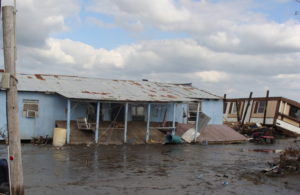
Albert Naquin, chief of the Isle de Jean Charles Band of Biloxi-Chitimacha (Sept. 29, 2009, AP Photo/Bill Haber)
The Biloxi-Chitimacha-Choctaw Indians are not strangers to the idea of forced migration. As a consequence of the Indian Removal Act of the 1830s, the tribe’s ancestors moved to the Isle de Jean Charles. Almost two hundred years after, they are being forced to move again as a result of climate change.
To address this issue, the federal government has provided 48 million dollars in order to move a majority of the island’s population of 85 people. Although the federal government has provided grants totaling one billion dollars for thirteen states, funding for “climate change refugees” is unprecedented.
The results of this program are fundamental in providing a potential blueprint for future resettlements resulting from climate change. It is estimated that 13.1 million Americans living seaside might face flooding as a result of rising sea levels. The issue of resettlement is complicated in itself. The issue in Isle de Jean Charles, however, is particularly complex because of the need to preserve what remains of the Biloxi-Chitimacha-Choctaw Indian community.
The story of the Isle de Jean Charles is particularly intriguing because of just how severe the ramifications of climate change combined with the increased rate of natural land loss due to the construction of dams and oil drilling. Isle de Jean Charles has lost 98% of its territory. Furthermore, frequent flooding and hurricanes have made farming impossible, contributing to the outward migration that has been occurring since 1955. The ones that have stayed behind despite worsening conditions, however, are strongly attached to their land, raising the broader question of how resettlement be carried out if the population in peril, refuses to move.
The Biloxi-Chitimacha-Choctaw Indians have voted twice before against resettlement. The issue of resettlement came up in 2002 when the Army Corps of Engineers (ACE), which had originally planned to include the Isle de Jean Charles in Gulf Hurricane Protection System, decided the cost and benefit did not add up. Because of the Isle’s remote location and relatively low economic value, ACE did not see the benefit. Instead, they offered the locals a plan of resettlement which, lacking unanimous support from the locals, were not implemented.
The Biloxi-Chitimacha-Choctaw Indians certainly won’t be the last U.S. climate refugees. In Alaska, more than 180 villages are currently directly affected by melting ice glaciers. A village called Newtok, according to Army Corps of Engineers is expected to be under water by next year. The locals, Eskimos, have been noticing the sinking for twenty years now and have been slowly rebuilding their community further inland. However, just as can be seen with the Biloxi-Chitimacha-Choctaw Indians, the effect displacement will have on a community so intimately connected to its land, given that they live off of it, is yet to be seen. Newtok, Alaska is one of many locations under the danger of going underwater. Tangier Island in the Chesapeake Bay and Quinault Indian Nation on Washington’s Olympic Peninsula are undergoing a similar catastrophe.
As part of the legacy he wants to leave on the issue of climate change, President Obama should ask Congress to set aside special funding for the next wave of climate refugees.





